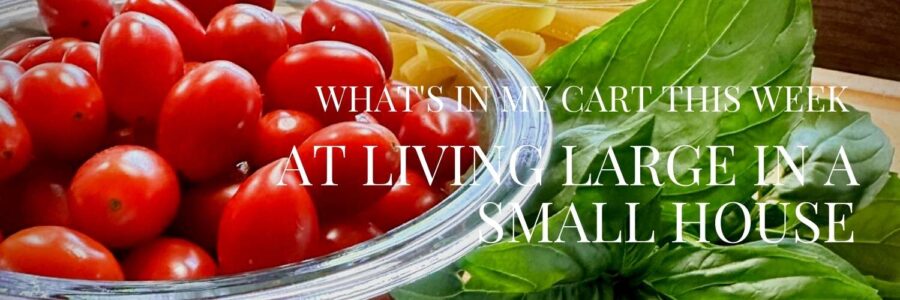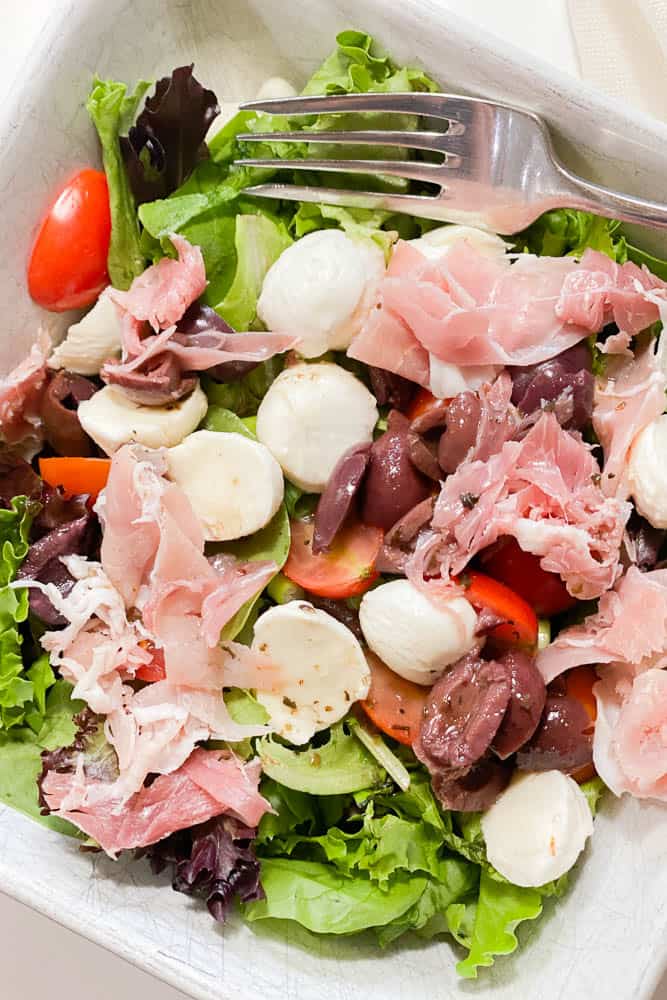Different Kinds of Rice: A Guide to Popular Varieties
Rice is a versatile food that can be prepared in many ways. There are different kinds of rice that vary in texture, flavor, and nutritional value. In this article, I’ll be sharing some information about the different kinds of rice that you may come across in your local grocery store or at a restaurant.
“Handy” is a meat and potatoes guy. I however don’t want potatoes with every meal. He will eat rice so we have that with our meals pretty often. Recently when our future daughter-in-law was visiting with our son, she introduced us to Basmati Rice. We love it.
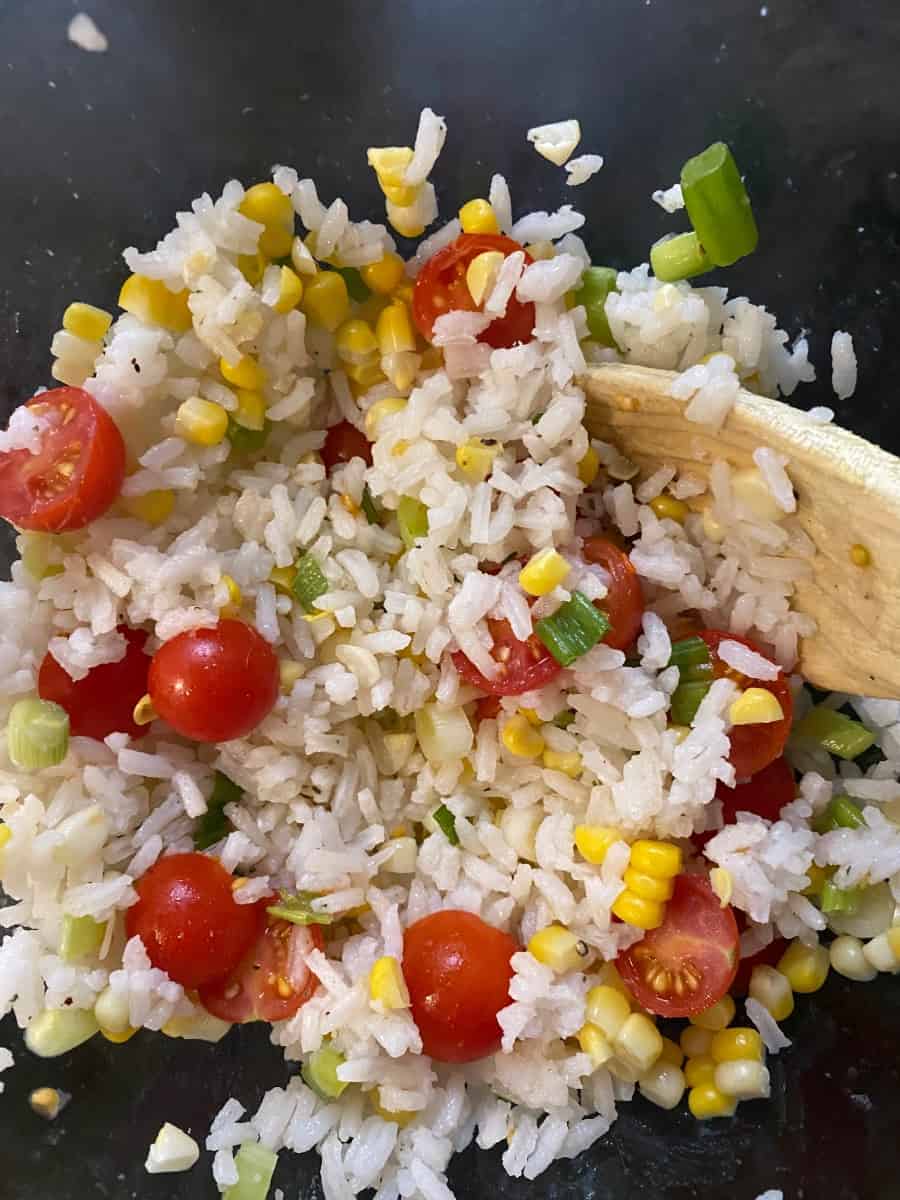
On my blog Living Large in A Small House, I may sometimes use affiliate links, which means a small commission is earned if you make a purchase via the link. The price will be the same whether you use the affiliate link or go directly to the vendor’s website using a non-affiliate link. You can find my full Disclosure Policy HERE
Basics of Rice
Rice is a staple food and a primary source of nutrition for millions of people worldwide.
It is a versatile grain that can be consumed in various forms, such as steamed, boiled, fried, and baked. In this section, I will cover some of the basics of rice, including its origin, types, and nutritional value.
Origin of Rice
Rice is believed to have originated in China over 5,000 years ago. From there, it spread to other parts of Asia, including India, Japan, and Southeast Asia. Today, rice is grown in many countries worldwide, including the United States, Brazil, and Australia.

Types of Rice
There are many types of rice varieties available, each with its unique flavor, texture, and nutritional value. Some of the most popular types of rice include:
- White rice: This is the most commonly consumed type of rice. It is milled to remove the outer husk, bran, and germ, leaving only the starchy endosperm.
- Brown rice: This type of rice is less processed than white rice and retains its bran and germ. It has a nuttier flavor and chewier texture than white rice.
- Basmati rice: This is a long-grain rice that is commonly used in Indian and Middle Eastern cuisine. It has a fragrant aroma and a delicate, fluffy texture.
- Jasmine rice: This is a fragrant, long-grain rice that is commonly used in Thai cuisine. It has a slightly sweet flavor and a soft, sticky texture.
What is the difference between long-grain rice, medium-grain rice, and short-grain rice
Long grain rice cooks up light, and fluffy, and will separate when cooked rather than clumping together. Medium-grain rice tends to cook up moist and tender while short-grain rice may clump together when cooked and form what is called glutinous rice
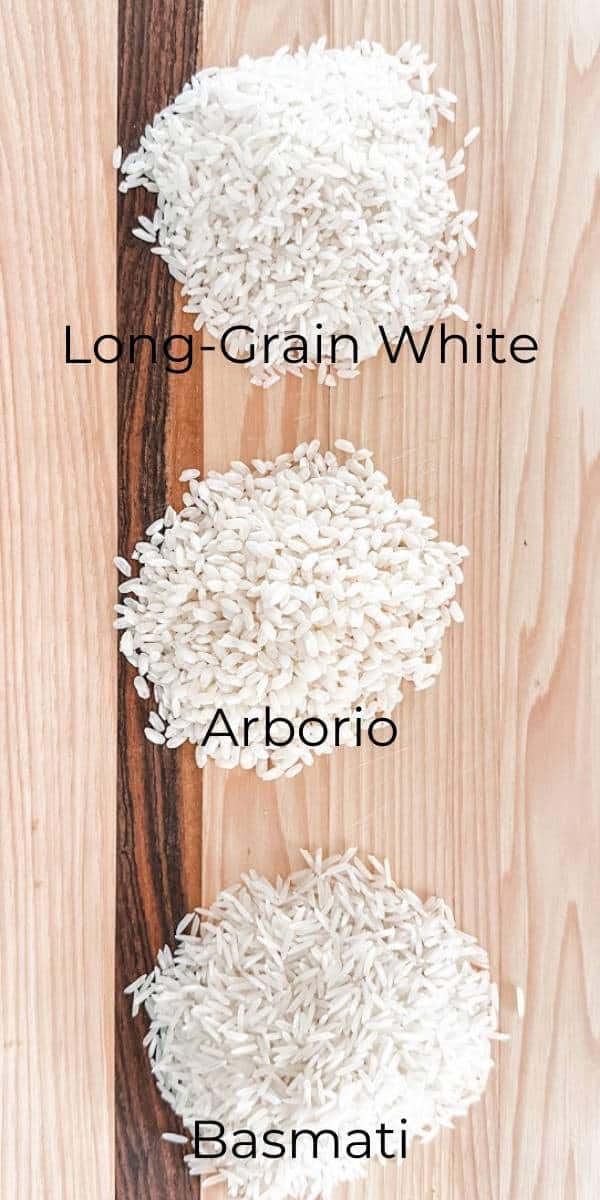
Nutritional Value of Rice
Rice is a good source of carbohydrates, which provide energy to the body. It also contains small amounts of protein, fiber, and essential vitamins and minerals. Brown rice is a better source of fiber and nutrients than white rice, as it retains its bran and germ. However, rice should be consumed in moderation, as it is high in carbohydrates and can lead to weight gain if eaten in excess.
That’s it for the basics of rice. In the following sections, I will cover some of the different types of rice in more detail.
White Rice
White rice is a staple in many cuisines around the world. It is a versatile grain that can be used in a variety of dishes. Here are a few types of white rice that I enjoy:
Basmati
Basmati rice is a long-grain rice that is commonly used in Indian, Pakistani, and Middle Eastern cuisine. It has a nutty flavor and a distinct aroma. Basmati rice is often used in biryanis, pilafs, and other rice dishes.
Jasmine
Jasmine rice is a fragrant rice that is commonly used in Thai and other Southeast Asian cuisines. It has a slightly sweet flavor and a delicate aroma. Jasmine rice is often used in stir-fries, curries, and other Asian dishes.
Arborio
Arborio rice is a short-grain rice that is commonly used in Italian cuisine. It has a high starch content and a creamy texture, which makes it ideal for making risotto. Arborio rice is often used in other creamy rice dishes as well.
Overall, white rice is a versatile and delicious grain that can be used in a variety of dishes. Whether you prefer basmati, jasmine, or arborio, there is a white rice variety that will suit your needs.

Brown Rice
Brown rice is a type of whole-grain rice that has not been stripped of its bran and germ. It is a healthier alternative to white rice, as it contains more fiber, vitamins, and minerals. There are two main types of brown rice: long grain and short grain.
Long Grain Rice
Long-grain brown rice is known for its slender, elongated grains that remain separate and fluffy when cooked. It has a nutty flavor and a chewy texture that make it a popular choice for pilafs, salads, and stir-fries. Here are some key facts about long-grain brown rice:
- It has a lower glycemic index than white rice, which means it can help regulate blood sugar levels.
- It is a good source of manganese, which is important for bone health and metabolism.
- It takes longer to cook than white rice, usually around 45-50 minutes.
Short Grain Rice
Short-grain brown rice is characterized by its plump, rounded grains that stick together when cooked. It has a sweeter taste and a softer texture than long-grain brown rice, which makes it ideal for dishes like sushi and risotto. Here are some important things to know about short-grain brown rice:
- It is higher in starch than long-grain brown rice, which gives it a creamier texture.
- It is a good source of selenium, which has antioxidant properties and may help prevent certain types of cancer.
- It cooks faster than long-grain brown rice, usually around 30-35 minutes.
In summary, brown rice is a nutritious and versatile grain that comes in two main varieties: long grain and short grain. Depending on your preference and the dish you are making, you can choose the type of brown rice that best suits your needs.
Basmati Rice
Equipment
- 2 small saucepans one with a tight fitting lid
Ingredients
- 1 cup basmati rice
- 1 tbsp butter
- 1-1/2 cup water or broth for more flavor
- 1/2 tsp salt
Instructions
Rinse Rice
- Using a small bowl and a strainer, rinse the rice in cold water in the bowl and strain, return to the bowl and rinse again. Continue rinsing and straining until the water in the bowl is clear then let the rice soak in the water for 20 minutes. Strain again before cooking.
Stove-Top Cooking
- In a small saucepan put the water on medium-high heat to bring to a boil.
- Melt the butter in the other heavy sauce pot over medium heat, then add the rinsed rice and cook, stirring for 2 minutes.
- Stir in the boiling water and salt, bring back to a boil over high heat.
- Reduce the heat to low, cover the pot and cook until rice is tender and liquid is absorbed, about 15 minutes.
- Remove the rice from the heat. Let stand covered and undisturbed for 5 minutes. Fluff rice with fork.
Nutrition
Wild Rice
Wild rice is a type of grass that grows in shallow water, typically in the Great Lakes region of North America. It has a nutty flavor and a chewy texture that makes it a popular ingredient in salads, soups, and casseroles.
I personally love wild rice because it’s so versatile and can be used in so many different dishes. It’s also a great source of protein, fiber, and antioxidants, making it a healthy addition to any meal.
When cooking wild rice, it’s important to note that it takes longer to cook than other types of rice. I usually simmer it in a pot of water for about 45 minutes to an hour, until the grains have popped open and are tender.
One of my favorite ways to enjoy wild rice is in a salad with roasted vegetables and a tangy vinaigrette. I also like to use it as a base for stuffed peppers or as a side dish with grilled chicken or fish.
Overall, wild rice is a delicious and nutritious ingredient that adds a unique flavor and texture to any dish.
Black Rice
Black rice, also known as forbidden rice, is a type of rice that has a deep black color and a nutty flavor. It is originally from China and is now widely grown in other parts of Asia, including Indonesia, Thailand, and the Philippines.
Black rice is a whole grain that is rich in antioxidants, fiber, and iron. It is also a good source of protein, making it a popular choice for vegetarians and vegans. Black rice is also gluten-free, making it a great option for those with gluten intolerance.
This type of rice is often used in sweet dishes, such as black rice pudding or black rice porridge. However, it can also be used in savory dishes, such as black rice salad or black rice stir-fry.
When cooking black rice, it is important to note that it takes longer to cook than white rice. It requires more water and a longer cooking time, but the result is a delicious and nutritious grain that is worth the wait.
Overall, black rice is a unique and healthy option for those looking to switch up their usual rice dishes.
Red Rice
Red rice is a type of rice that has a reddish-brown color and a nutty flavor. It is a whole grain rice, which means that it has not been stripped of its bran and germ, making it a healthier option than white rice.
Red rice is commonly grown in Southeast Asia, and it is a staple food in many countries, including Thailand and India. It is also becoming more popular in Western countries due to its health benefits.
Here are some key facts about red rice:
- Red rice is high in fiber, which can help regulate digestion and lower cholesterol levels.
- It is also rich in antioxidants, which can help protect the body from damage caused by free radicals.
- Red rice has a lower glycemic index than white rice, which means that it can help regulate blood sugar levels.
- It is a good source of iron, which is important for maintaining healthy blood cells.
Red rice can be cooked in the same way as white rice, and it can be used in a variety of dishes, including salads, stir-fries, and soups. It has a slightly chewy texture and a nutty flavor that pairs well with a range of ingredients.
Overall, red rice is a nutritious and flavorful alternative to white rice that is worth trying if you are looking to add more variety to your diet.
Rice
noun. ˈrīs. : the starchy seeds of an annual southeast Asian cereal grass (Oryza sativa) that are cooked and used for food. also: this cereal grass is widely cultivated in warm climates for its seeds.
Aromatic Rice
When it comes to rice, there are many different types to choose from. One of my personal favorites is aromatic rice. This type of rice is known for its fragrant aroma and unique flavor. In this section, I’ll introduce you to three different types of aromatic rice: Texmati, Wehani, and Black Japonica.
Texmati
Texmati is a type of aromatic rice that is grown in Texas. It has a nutty flavor and a distinctive aroma that is similar to that of basmati rice.
Texmati rice is also known for its long, slender grains that stay fluffy and separate when cooked. Here are some key facts about Texmati rice:
- Origin: Texas
- Flavor: Nutty
- Aroma: Fragrant, similar to basmati rice
- Grain shape: Long and slender
- Texture: Fluffy and separate
Wehani
Wehani rice is a unique type of aromatic rice that is reddish-brown in color. It has a nutty flavor and a sweet aroma that is similar to that of popcorn. Wehani rice is also known for its chewy texture and ability to absorb flavors well. Here are some key facts about Wehani rice:
- Origin: California
- Flavor: Nutty, sweet
- Aroma: Fragrant, similar to popcorn
- Grain shape: Medium length, slender
- Texture: Chewy
Black Japonica
Black Japonica is a type of aromatic rice that is a blend of black and mahogany rice. It has a nutty flavor and a sweet aroma that is similar to that of brown rice.
Black Japonica rice is also known for its unique appearance, with black and mahogany grains mixed together. Here are some key facts about Black Japonica rice:
- Origin: United States
- Flavor: Nutty, sweet
- Aroma: Fragrant, similar to brown rice
- Grain shape: Short and plump
- Texture: Tender
That’s it for our introduction to aromatic rice! Whether you prefer the nutty flavor of Texmati, the sweet aroma of Wehani, or the unique appearance of Black Japonica, there’s an aromatic rice out there for everyone.

Rice in Cuisine
Rice is a staple food in many cultures around the world, and it is used in a wide variety of dishes. Here are a few examples of how rice is used in different cuisines.
Asian Cuisine
In many Asian countries, rice is a dietary staple and is often served with every meal. Some popular Asian rice dishes include:
- Fried rice: A dish made by stir-frying cooked rice with vegetables, eggs, and meat.
- Sushi: A Japanese dish made with rice, vinegar, and various fillings such as fish or vegetables.
- Congee: A Chinese rice porridge that is often served for breakfast.
Latin American Cuisine
Rice is also a prominent ingredient in Latin American cuisine. Some popular dishes include:
- Arroz con pollo: A Spanish dish made with rice, chicken, and vegetables.
- Gallo pinto: A Costa Rican dish made with rice and beans.
- Paella: A Spanish dish made with rice, seafood, and various meats.
Middle Eastern Cuisine
Rice is a staple in Middle Eastern cuisine and is often served with meat or vegetable dishes. Some popular Middle Eastern rice dishes include:
- Pilaf: A dish made by cooking rice in broth with vegetables, spices, and sometimes meat.
- Mujadara: A Lebanese dish made with rice and lentils.
- Biryani: An Indian dish made with rice, spices, and meat or vegetables.
Overall, rice is a versatile ingredient that can be used in a wide variety of dishes from around the world.
Health Benefits and Nutritional Value
As a health-conscious person, I include rice in my diet. Rice is a staple food for many people around the world and it is an excellent source of energy. In this section, I will discuss the health benefits and nutritional value of rice.
Rice is a good source of carbohydrates, which is the primary source of energy for our body. It contains essential amino acids that our body needs to build and repair muscles. Rice is also low in fat and cholesterol, making it a healthy food choice.
In addition to carbohydrates and amino acids, rice also contains vitamins and minerals. Here are some of the essential vitamins and minerals found in rice:
- Vitamin B: Rice is a good source of vitamin B, which is essential for maintaining a healthy nervous system.
- Iron: Rice contains iron, which is necessary for the production of hemoglobin, a protein in red blood cells that carries oxygen throughout the body.
- Zinc: Rice is a good source of zinc, which is essential for a healthy immune system.
- Magnesium: Rice contains magnesium, which is important for maintaining healthy bones and muscles.
One of the best things about rice is that it is gluten-free, making it an excellent choice for people with celiac disease or gluten intolerance. Additionally, rice is easy to digest, making it a good food choice for people with digestive issues.
We have two kids who should be following a gluten-free diet. One is pretty good about it and the other not so much. I like being able to add rice to meals when they are here as a gluten-free option.
Overall, rice is a healthy and nutritious food that should be included in everyone’s diet. It provides essential nutrients, is easy to digest, and is a great source of energy.

Conclusion
In this article, I have explored the different kinds of rice that are commonly consumed around the world. From short-grain sushi rice to long-grain basmati rice, (our new favorite) each type has its unique characteristics and uses.
I have discussed how the texture, flavor, and aroma of rice can vary depending on the type of rice and how it is cooked. I have also highlighted the nutritional benefits of rice, which is a good source of carbohydrates and essential vitamins and minerals.
It is worth noting that there are many other types of rice that are not covered in this article.
In conclusion, rice is a versatile and nutritious food that can be enjoyed in many different ways. Whether you prefer it as a side dish or a main course, there is a type of rice that will suit your taste and dietary needs.
Peace and. Love,
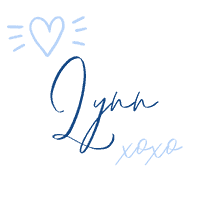

Thanks for Following Along
If you enjoyed this post I hope you sign up to be a friend of Living Large in A Small House! Then you won’t miss any of the inspiration that is shared with you each week! You can also follow me on Instagram, Facebook, and YouTube. I share even more inspiration on Pinterest! You can listen to me chat on my Podcast.


A great way to remember this recipe is to save it to your Pinterest boards. You can find the pin button in the top right corner of the photo below. Also, don’t forget to follow me on Pinterest


